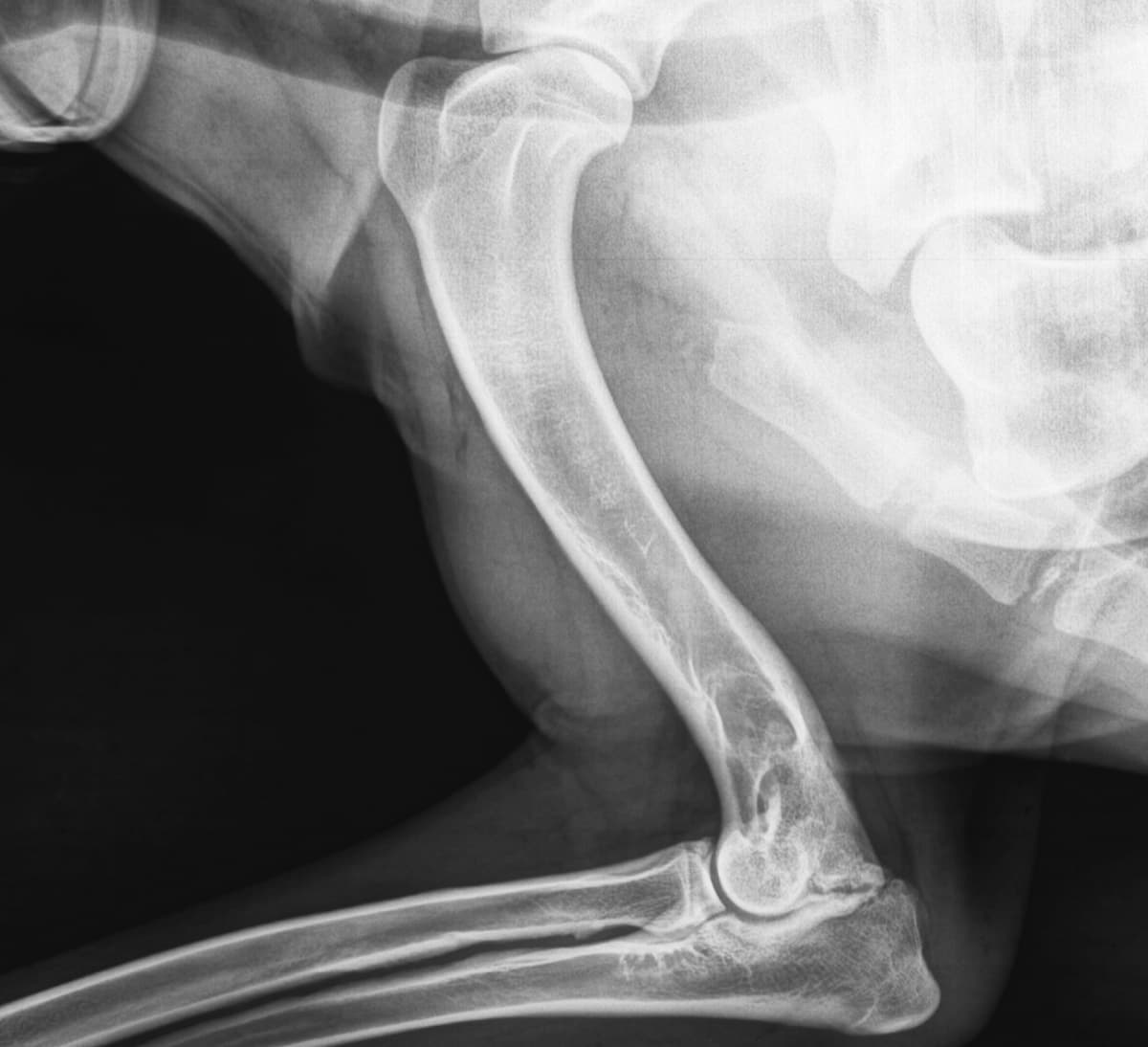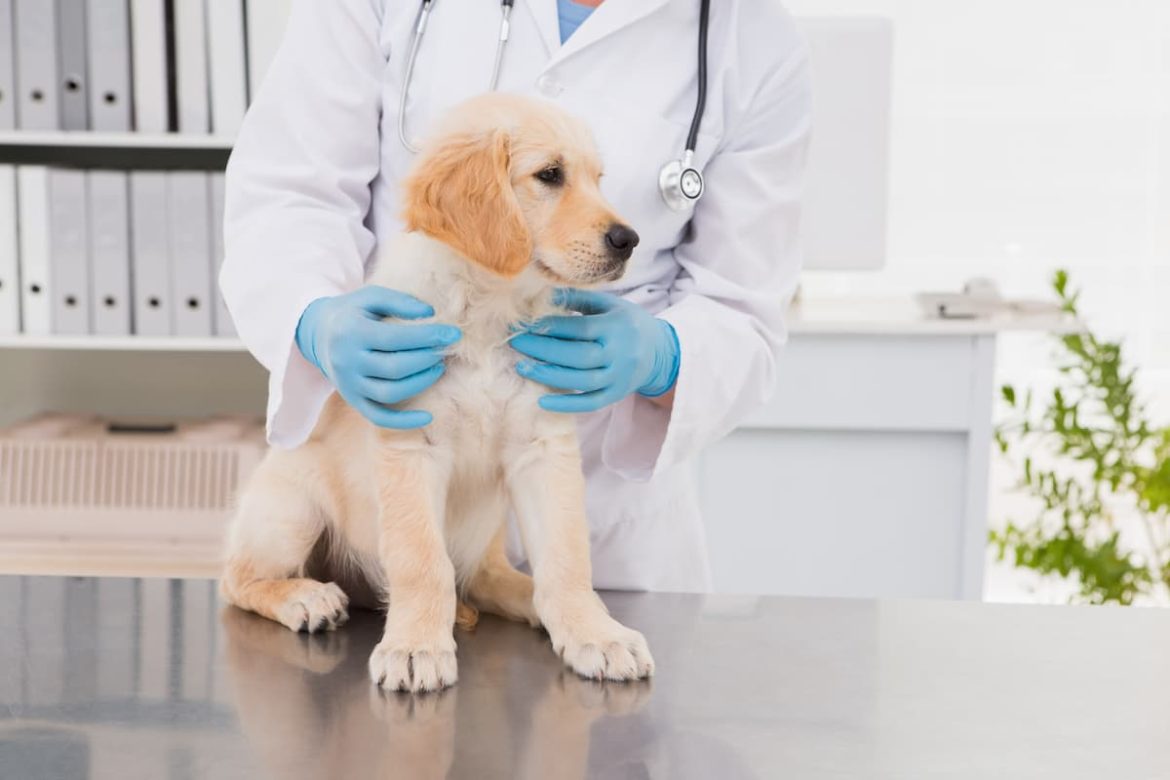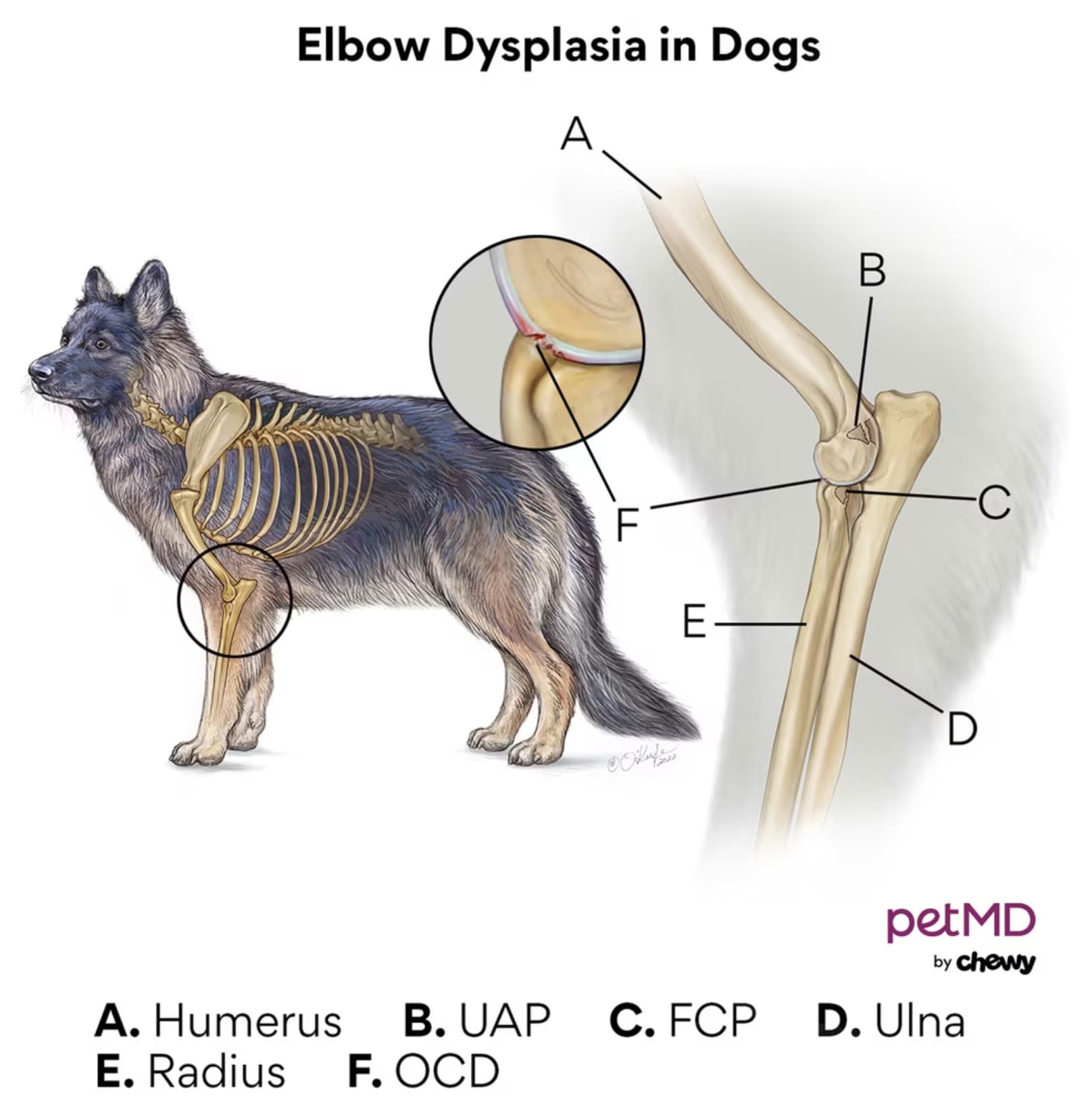If you notice your dog limping, it could be a sign of elbow dysplasia, a condition that causes pain and lameness due to the abnormal growth of the elbow joint. This can be caused by several factors, including genetics, nutrition, and environment.
When your dog is limping for more than a few days or if they seem to be in pain or discomfort, it’s important to take them to the vet as soon as possible so that a specialist perform tests such as x-rays to diagnose the cause of the limp and develop an appropriate treatment plan.
Left untreated, elbow dysplasia can lead to arthritis and other complications. In this article, we will discuss the symptoms of elbow dysplasia in dogs, its causes, and treatments available for managing the condition.
What Is Elbow Dysplasia in Dogs?
Canine elbow dysplasia is an abnormal development of the elbow, characterised by irregular bone growth in which the three bones of the elbow joint fail to fit together correctly. This can lead to pain and discomfort for dogs, reduced mobility and other complications. Irregular weight distribution on the joint often leads to pain and lameness, leading to arthritis if not treated properly.
Symptoms of dog elbow dysplasia include:
- Your dog displays signs of pain when they bend or straighten the elbow joint
- Occasional or persistent lameness, which is worsened by exercise
- Decreased range of motion in the elbows
- Swelling around the elbow joint
- Difficulty standing up
- Abnormal gait
- Your dog is reluctant to play or go for a walk
- There is a crackling sound when your dog bends or extends their elbow
- Your dog holds their elbow at odd angles
What Causes Elbow Dysplasia?
Canine elbow dysplasia is a common condition in dogs that occurs when the bones of the elbow joint fail to develop correctly. Various factors, including trauma, nutritional deficiencies, defects in bone development, and hormonal influences, can cause it.
A dog’s elbow comprises three bones: the radius, humerus, and ulna. Four different skeletal conditions contribute to dog elbow dysplasia, a combination of which can be present in dogs diagnosed with this condition.
UAP – Ununited Anconeal Process
Ununited anconeal process is a condition in which the anconeal process, a part of the ulna, fails to fuse or detaches from the bone. When the growth plate fails to close, it causes a piece of bone to detach and irritate the joint. This can result in pain and swelling in the affected area, as well as difficulty with movement.
FCP – Fragmented Coronoid Process
Fragmented Coronoid Process is a condition in which a piece of bone in a dog’s elbow joint breaks off and irritates the joint lining, causing the cartilage to erode. This piece of bone is called the coronoid process, an essential part of the elbow joint in dogs. When this process fails to attach correctly, it can lead to discomfort, pain, and even lameness.
MCD – Medial Compartment Disease
Medial Compartment Disease is a condition that affects the joints in dogs. It occurs when there is abnormal pressure on the joint, which causes one joint to wear away the other. This can lead to bone exposure, pain and inflammation. MCD is considered one of the worst forms of dysplasia as it can cause severe pain and discomfort but can not be reversed. Further research is required to determine whether surgery may be a possibility in the future.
Osteochondrosis of the medial humeral condyle
Osteochondrosis of the medial humeral condyle in dogs is a condition that can cause pain and swelling in the shoulder joint. It occurs when the cartilage fails to turn into bone and replaces bone as the articulating surface. This can lead to inflammation and degeneration of the joint, causing pain for your pet.
How Is Dog Elbow Dysplasia Diagnosed?
Suppose you suspect your dog may have (or be at risk of developing) elbow dysplasia. In that case, you must book a consultation with your vet, who can examine your dog for any signs of pain and locate any areas of potential weakness or lameness.
There are several methods available for vets to diagnose this condition. They can use a physical exam to locate the source of pain, as well as x-rays of the affected limb (and sometimes the opposite limb for comparison). This helps them determine if any damage or deformity in the joint is causing the issue.
However, if nothing shows up on the x-ray images, vets may use CT scans or arthroscopy to better look at the affected area. These scans can provide more detailed pictures of the elbow joint that may reveal signs of elbow dysplasia.
With these tools, vets can accurately diagnose elbow dysplasia in dogs and recommend appropriate treatment options.
Early signs of elbow dysplasia can be challenging to identify, but getting an early diagnosis can help prevent osteoarthritis in your dog’s joints. Therefore, it’s crucial to keep an eye out for the following early warning signs:
- Your dog occasionally walks with a limp, particularly if they’ve been running around or just stood up after lying down
- Their elbow joint seems stiff and rotates outward when their front legs rotate inward
- There is a crackling sound when your dog bends or stretches their elbow
- Your dog becomes hesitant to engage in walks or playtime as they usually would
 Which Dog Breeds Are Vulnerable To Elbow Dysplasia?
Which Dog Breeds Are Vulnerable To Elbow Dysplasia?
Almost all dogs are susceptible to elbow dysplasia, but some breeds are more likely to develop this condition than others, particularly medium to large dog breeds like the following:
- Rottweiler
- Labrador Retriever
- Golden Retriever
- Shar Pei
- Bernese Mountain Dog
- German Shepherd
- Newfoundland
- English Springer Spaniel
- Basset Hound
Treatment and Prevention For Elbow Dysplasia in Dogs
The treatment options for dog elbow dysplasia depend on the severity of the condition. Mild cases may be treated with anti-inflammatory drugs and joint supplements to reduce inflammation and pain. But, if the condition is more severe, surgery may be required to correct the underlying problem. In either case, regular check-ups with a veterinarian are important to monitor your dog’s progress and adjust treatment accordingly.
Joint supplements are an excellent way to promote healing through decreased inflammation and increased water retention (to provide more cushioning for the joint). In addition, they are an excellent way to reduce the risk of your pup developing elbow dysplasia in the first place.
Popular options include the following:
- Antinol: a natural joint supplement that helps improve your dog’s mobility and assists in relieving the symptoms of arthritis. This fast-acting supplement has no known side effects and can provide results in as little as ten days. It can also be used in conjunction with a range of other medications.
- 4CYTE: a plant oil extract used for cartilage regeneration. This can be highly effective in helping pre and post-op dogs and those with pre-existing osteoarthritis or stiff joints.
- PAW By Blackmores Joint Care: highly palatable dog chews that are easy to administer and offer a balanced combination of nutrients for joint health. These are ideal for pups showing signs of limping, stiffness, or reluctance to engage in playtime.
It’s important to remember that if you intend to administer drugs or supplements to your dog, you should always consult with your vet first.
Other steps to help prevent your dog from developing this condition include keeping your dog healthy through regular exercise, maintaining a healthy weight, and regular vet check-ups. Providing your dog with the right nutrition and supplements can also help reduce the risk of elbow dysplasia. Taking these preventive measures can help ensure your dog stays happy and healthy for years.


